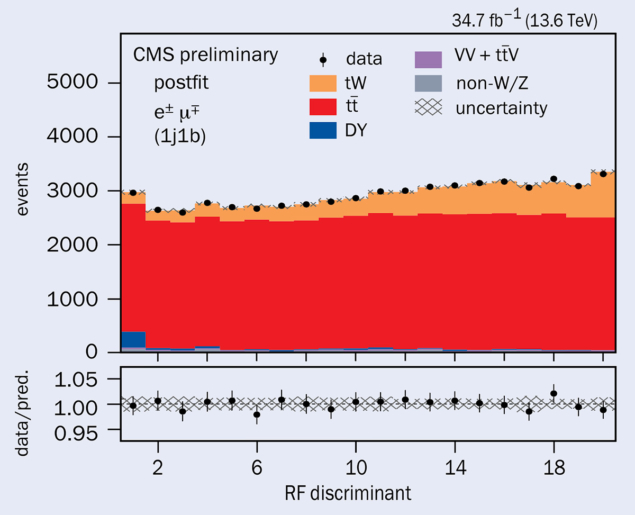A report from the CMS experiment.

Being the most massive known elementary particle, top quarks are a focus for precision measurements and searches for new phenomena. At the LHC, they are copiously produced in pairs via quantum chromodynamic (QCD) interactions, and, to a much lesser extent, in single modes through the electroweak force. Precisely measuring the single-top cross section provides a stringent test for the electroweak sector of the Standard Model (SM) of particle physics.
In September 2022, only four months after the start of the Run 3, the CMS collaboration released the first measurement using data at the new collision energy of 13.6 TeV: the production cross section of a top quark together with its antiparticle (tt). The collaboration can now also report a measurement of the production of a single top quark in association with a W boson (tW) based on the full dataset recorded in 2022. As well as testing the electroweak sector, constraining tW allows it to be better disentangled from the dominant tt process – a channel where precision improves our knowledge of higher orders of accuracy in perturbative QCD.

tW is a challenging measurement as it is 10 times less likely than tt production but has almost the same detection signature. This analysis selects events where both the top quark and the W boson ultimately decay to leptons. The signal therefore consists of two leptons (electrons or muons), a jet initiated from a bottom quark, and possibly extra jets coming from additional radiation. No single observable can discriminate the signal from the background, so a random forest (RF) is employed in events that contain either one or two jets, one of which comes from a bottom quark. The RF is a collection of decision trees collaborating to distinguish the tW signal from the tt background. The output of the RF, for events with one jet identified as coming from a bottom quark, is shown in figure 1. The higher the RF discriminant, the higher the relative proportion of signal events.
To achieve a higher precision, an extra handle is used to control the tt background: information from events with two b-quark jets. Such events are more likely to come from the decay of a tt pair. The measurement yields a precise value for the tW cross section. Figure 2 shows tW cross-section measurements by CMS at different centre-of-mass energies, including the new measurement in proton–proton collisions of 13.6 TeV. All measurements are consistent with state-of-the-art theory calculations. The first tW measurement at the new LHC energy frontier uses only part of the data but is already as precise as the earlier measurement, which used the entire Run 2 sample at 13 TeV. Exploiting the full Run 3 data sample will push the precision frontier forward and provide an even more stringent SM probe in the top quark sector.
Further reading
CMS Collab. 2024 CMS-PAS-TOP-23-008.







